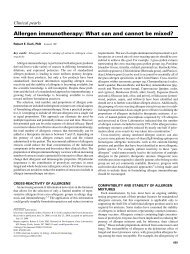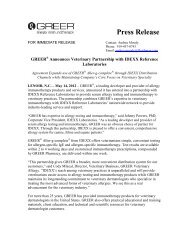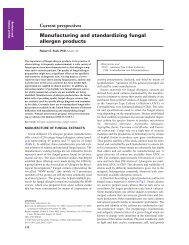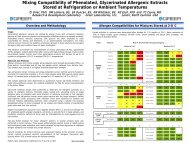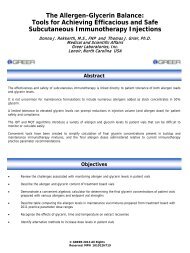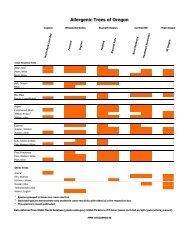Human Allergy Catalog - Greer
Human Allergy Catalog - Greer
Human Allergy Catalog - Greer
You also want an ePaper? Increase the reach of your titles
YUMPU automatically turns print PDFs into web optimized ePapers that Google loves.
DOSAGE AND ADMINISTRATIONA. Testing:1. Scratch and Prick testing normally employ 1:20 glycerinated extracts, whichcontain 125-250 units Antigen E per mL (Short Ragweed) or 75-150 unitsAntigen E per mL (Ragweed Mix).2. Intradermal testing with Short Ragweed and G.S. Ragweed Mix is routinelyperformed using 1:1000 w/v and 1,000 PNU/mL or more dilute material. It hasbeen reported that as little as 10 -6 unit (0.000001 µg) is sufficient to cause apositive skin test. In another study of 25 Antigen E sensitive individuals, thedose required for a 2+ reaction (8-10 mm wheal) ranged from 10 -6 to 10 -1 µgAntigen per mL using a 0.5 mL dose. 3Individual sensitivity to Ragweed extracts will vary greatly and it isrecommended that intradermal testing be started at low concentrations (i.e.0.05 mL at 0.1 µg/mL- dose equals 0.005 µg Antigen E). If no reaction occurs,testing may be repeated with a stonger dilution.B. Treatment:Initial and subsequent treatment dosage must be based on careful testingprocedures and evaluation of patient history. Studies have shown a definitecorrelation between symptom amelioration and maximum or cumulative dosageachieved. One study 5 has shown significant clinical improvement with an averagecumulative preseasonal dosage equivalent to 252 µg of Antigen E, but nosignificant improvement with an average cumulative dosage of 32 µg Antigen E.In another study 8 a mean cumulative dosage of 84.9 µg Antigen E (as wholeragweed extract) was significantly effective in reducing allergenic symptomscompared to placebo.The dosage schedule shown below, based on Antigen E content, will deliverapproximately 85 µg Antigen E in 18 injections. Initial and subsequent treatmentdosage must be based on careful testing procedures and patient history. Highlysensitive individuals will require lower initial dosage, more moderate dosageincrease, and may not tolerate as high a maintenance dosage as the moderatelysensitive individual. The suggested schedule shown below is for a moderatelysensitive individual and must be modified by the physician to suit each patient ifnecessary.



